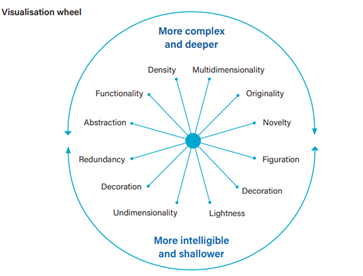How to Responsibly Visualise or Communicate with M&E Data
Stage 6 of responsible data governance, as per our guiding framework offers guidance on M&E communication, from identifying audience requirements to designing data visualisations that avoid biased interpretations. It includes a review on developing a data visualisation and information on lessons learnt from COVID-19 visualisations.
While M&E practitioners have traditionally relied on written text, visualisations are increasingly being recognised as valid and useful ways of summarising, presenting, and communicating development-related data. This trend has been influenced by the proliferation of user-friendly tools and greater global digitisation.
Guidelines for M&E data design and communication
1. Know your audience and what forms of communication are accessible and useful for them
Data literacy is “the ability to read, work with, analyse and argue with data.” A determination of the data literacy level of the target audience will assist you in deciding on the complexity of the visuals. It will also help you to choose the approach – whether it should be author-driven or reader-driven.
In determining the suitability of visuals for an audience, it is also relevant to reflect on the following three contextual factors:
An important first step in deciding on the type of visualisation relates to the target audience. Not everyone has the same level of data literacy. Cultural and other factors influence how well someone will understand a visualisation. As such, one of the first questions to ask when designing a visual is: “How data-literate is my audience?”

Not all users will be equally motivated and interested in seeing the data, so the visual needs to catch their attention and relate to their frames of reference. It is also important to keep in mind that a window of 5–10 minutes is often all the time available for capturing the attention of policymakers.
2. Make the ‘right’ design choices for your audience
When the specific interests and needs of your audience/s have been considered and identified, a decision can be made on your communication outputs. This means making visualisation and communication choices that best suit the audience (and not merely resorting to a personal preference or a generic one-size-fits-all approach).
Making poor choices for the data user can leave the audience confused, lead to misinterpretation of data, or cause people to lose interest in the information before the salient points are presented.
The following two simple steps can assist you in making choices about data visualisation and communication:
- determine the level of simplification of information needed (e.g. a detailed dashboard with many graphs vs. a bullet list of key findings)
- choose the most appropriate presentation elements to present the data (e.g. bar chart vs. tables). The visualisation wheel includes 12 dimensions of a visualisation that should be considered.

3. Create an appropriate channel and medium
Once you’ve decided on the appropriate content and design of your data visualisation or communication output, the next step is to devise the most effective way to convey the data information to your audience.
The internet and digital technology have influenced the proliferation of channels for disseminating information, such as YouTube, Zoom, Facebook, etc. It is important to consider which channels your audience can access – is the internet the best channel or is sharing printed one-pagers more appropriate?
The below table provides a few examples of media that might be chosen for different channels.

Finally, you must stress-test the sustainability of your output. How long must your audience have access to your report or infographic? What implications will this have on cost and access? To ensure long-term access to information, identify open source or low-cost media to maximise access and ensure longevity of the information’s use/usefulness.
Stephen Few developed a useful data visualisation effectiveness profile as a means to assess different visuals based on two dimensions and seven criteria of data visualisations. The two dimensions are emotive and informative.
- Informative dimensions include usefulness, completeness, perceptibility, truthfulness, and intrusiveness.
- The emotive dimension is important in enhancing engagement with the information you share.
The emotive dimension is often overplayed, thereby over-sensationalising data and serving to detract from constructive critique or a real understanding of the meaning of the data.
Prior sharing of draft visuals with the audience or with a colleague for their inputs will help to pinpoint aesthetic elements that are either confusing or missing from a visual.
While visualisations can help to communicate data and improve our understanding of the world, they have their limitations. Some visualisations fail to provide useful data but, instead, leave the audience confused and frustrated.
See tip sheet 8 for Improving data visualisation
Stay tuned to the next and last stage of the cycle, Responsible data retention, maintenance, and destruction as we unpack more on the practical responsible data management tips for M&E practitioners.
See our previous blog posts on: Responsible Data Management for M&E: Stage 1 – Design and Planning , How to responsibly collect or acquire data for M&E, How to Responsibly Transmit and Store M&E Data, How to responsibly Clean, Analyse and Use Data and How to responsibly open data and share data, to keep up with the discussion, or learn more from the report.
You might also like
-
What’s happening with GenAI Ethics and Governance?
-
Join the AI and African Evaluation Working Group Meet ‘n’ Mix Session on May 7!
-
Hands on with GenAI: predictions and observations from The MERL Tech Initiative and Oxford Policy Management’s ICT4D Training Day
-
When Might We Use AI for Evaluation Purposes? A discussion with New Directions for Evaluation (NDE) authors